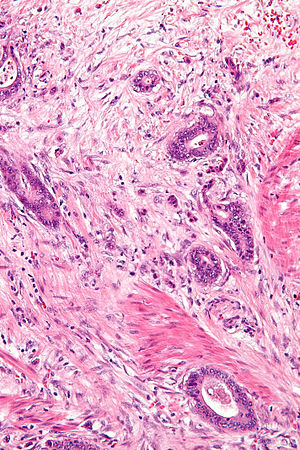Difference between revisions of "Tumour budding"
Jump to navigation
Jump to search
| Line 6: | Line 6: | ||
==Microscopic== | ==Microscopic== | ||
Definition - rectal carcinoma: | Definition - rectal carcinoma:<ref name=pmid28548122>{{Cite journal | last1 = Lugli | first1 = A. | last2 = Kirsch | first2 = R. | last3 = Ajioka | first3 = Y. | last4 = Bosman | first4 = F. | last5 = Cathomas | first5 = G. | last6 = Dawson | first6 = H. | last7 = El Zimaity | first7 = H. | last8 = Fléjou | first8 = JF. | last9 = Hansen | first9 = TP. | title = Recommendations for reporting tumor budding in colorectal cancer based on the International Tumor Budding Consensus Conference (ITBCC) 2016. | journal = Mod Pathol | volume = 30 | issue = 9 | pages = 1299-1311 | month = Sep | year = 2017 | doi = 10.1038/modpathol.2017.46 | PMID = 28548122 }}</ref> | ||
*Tumour bud = 1-4 cell(s) -- at the tumour front. | *Tumour bud = 1-4 cell(s) -- at the tumour front. | ||
* | |||
Grading: | |||
*Low grade: 0-4 tumour buds. | |||
*Intermediate grade: 5-9 tumour buds. | |||
*High grade: >=10 tumour buds. | |||
Note: | Note: | ||
* | *Assessed in a field area of 0.385 mm<sup>2</sup>.<ref name=pmid28548122/> | ||
**Tumour budding was '''previously''' assessed in a field of 0.385 mm<sup>2</sup>.<ref name=pmid11952856>{{Cite journal | last1 = Ueno | first1 = H. | last2 = Murphy | first2 = J. | last3 = Jass | first3 = JR. | last4 = Mochizuki | first4 = H. | last5 = Talbot | first5 = IC. | title = Tumour 'budding' as an index to estimate the potential of aggressiveness in rectal cancer. | journal = Histopathology | volume = 40 | issue = 2 | pages = 127-32 | month = Feb | year = 2002 | doi = | PMID = 11952856 }}</ref> | |||
** | |||
DDx: | DDx: | ||
Revision as of 16:14, 6 September 2017
Tumour budding refers to lone tumour cells or small clusters of tumour cells at the advancing front of a tumour.[1]
General
- Poor prognosticator in colorectal carcinoma,[2] and invasive ductal carcinoma of the breast.[3]
Microscopic
Definition - rectal carcinoma:[4]
- Tumour bud = 1-4 cell(s) -- at the tumour front.
Grading:
- Low grade: 0-4 tumour buds.
- Intermediate grade: 5-9 tumour buds.
- High grade: >=10 tumour buds.
Note:
- Assessed in a field area of 0.385 mm2.[4]
- Tumour budding was previously assessed in a field of 0.385 mm2.[1]
DDx:
- Poorly differentiated adenocarcinoma.
Images
Tumour budding in CRC - intermed. mag. (WC)
See also
References
- ↑ 1.0 1.1 Ueno, H.; Murphy, J.; Jass, JR.; Mochizuki, H.; Talbot, IC. (Feb 2002). "Tumour 'budding' as an index to estimate the potential of aggressiveness in rectal cancer.". Histopathology 40 (2): 127-32. PMID 11952856.
- ↑ Mitrovic, B.; Schaeffer, DF.; Riddell, RH.; Kirsch, R. (Oct 2012). "Tumor budding in colorectal carcinoma: time to take notice.". Mod Pathol 25 (10): 1315-25. doi:10.1038/modpathol.2012.94. PMID 22790014.
- ↑ Gujam, FJ.; McMillan, DC.; Mohammed, ZM.; Edwards, J.; Going, JJ. (Sep 2015). "The relationship between tumour budding, the tumour microenvironment and survival in patients with invasive ductal breast cancer.". Br J Cancer 113 (7): 1066-74. doi:10.1038/bjc.2015.287. PMID 26263482.
- ↑ 4.0 4.1 Lugli, A.; Kirsch, R.; Ajioka, Y.; Bosman, F.; Cathomas, G.; Dawson, H.; El Zimaity, H.; Fléjou, JF. et al. (Sep 2017). "Recommendations for reporting tumor budding in colorectal cancer based on the International Tumor Budding Consensus Conference (ITBCC) 2016.". Mod Pathol 30 (9): 1299-1311. doi:10.1038/modpathol.2017.46. PMID 28548122.



